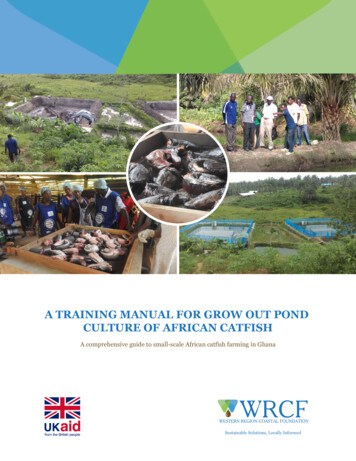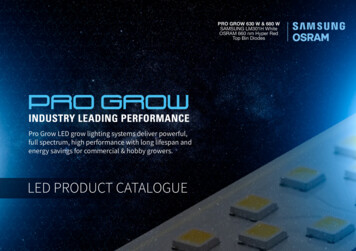
Transcription
A TRAINING MANUAL FOR GROW OUT PONDCULTURE OF AFRICAN CATFISHA comprehensive guide to small-scale African catfish farming in GhanaSustainable Solutions, Locally Informed
Implementation AgencyWestern Region Coastal Foundation (WRCF)www.wrcfghana.orgProject ConsultantCSIR-Water Research Institute,Aquaculture Research and Development Center (ARDEC), Akosombo, Eastern Region, Ghana.www.csir-water.com,Contributing AuthorsMr Etornyo Agbeko (CSIR, WRI)Dr. Ruby Asmah (CSIR, WRI)Dr. Francis A. Anani (CSIR, WRI)Mr. Emmanual Tetteh-Doku Mensah (CSIR, WRI)Edited byBarbara Joelle Wahi (WRCF)Etornyo Agbeko (CSIR, WRI)This publication is available electronically on the WRCF website at www.wrcfghana.orgFor more information contact: Western Regional Coastal Foundation, No. 9 Falcner Ave, West AnajiTakoradi. Email: info@wrcfghana.org, Postal Box MC 3609, Takoradi, GhanaCover PhotosWestern Region Coastal FoundationTraining Manual for African Cat ish farming in Western Region, GhanaPage 2
TABLE OF CONTENTSPREFACE . 5ACKNOWLEDGEMENTS . 6DISCLAIMER . 61234INTRODUCTION TO AFRICAN CATFISH FARMING AS A BUSINESS . 71.1African catfish farming . 71.2General Characteristics of the African Catfish (Why farm catfish) . 81.3Why Some Fish Farmers Fail . 10MODULE 1: PRE-STOCKING MANAGEMENT . 142.1Fish Pond Construction. 142.2Construction of dug-out earthen ponds . 162.3Procedures for constructing earthen pond (Profiling for re-construction of earthen ponds) . 182.4Compacting pond dikes and embankment / levee . 232.5Construction of Monk (Water control structure) . 262.6Preparation of pond for stocking with fish . 31MODULE TWO: STOCKING MANAGEMENT . 353.1Quality fish seed to be stocked. . 353.2Size of fingerling to stock . 363.3Number of fish seed to be stocked . 363.4Transport of fingerlings . 373.5Sorting and grading . 40MODULE THREE: POST STOCKING MANAGEMENT. 434.1Liming after stocking . 434.2Fertilization . 434.3Feeds (Diets) and Feeding Of Cultured Catfish in Ponds . 444.4Growth Monitoring (Sampling) in Fish Culture . 604.5Fish Health Management. 624.6Water Quality Management . 634.7African Catfish Farming as a business . 65Record Keeping . 655MODULE FOUR: HARVESTING AND MARKETING . 73Training Manual for African Catfish farming in Western Region, GhanaPage 3
65.1Harvesting techniques . 735.2Handling and processing . 75BIBLIOGRAPHY . 78Training Manual for African Catfish farming in Western Region, GhanaPage 4
PREFACEThe Western Region Coastal Foundation is a locally owned and managed independent foundation witha legal charter as an NGO in Ghana. Our governance structure includes representatives fromcommunities, local government and companies. As the oil, gas, power (OGP) and other extractiveindustries increase activity in the Western Region, they are affecting daily life for residents of theregion’s six coastal districts. This creates risks and operational challenges - increasing expectations bygovernment, traditional authorities and others. It also offers opportunities.Managing these risks and capitalising on these opportunities requires local knowledge, expertise andcollective commitment to local economic and social development over the long term. Through datagarnered from our innovative multi-stakeholder dialogue platform, WRCF is actively identifying anddesigning ways to add value to new or existing initiatives in private sector development to createeconomic growth in the region.WRCF promotes inclusive economic development, translating its wealth of data and relationshipsinto local solutions for sustainable development. We identify and design pilot projects that strengthensocial license and support community development. We also lend our technical expertise to externalprojects, independently assessing and evaluating the impact of Corporate Social Investments (CSI).The Aquaculture initiative implemented by WRCF seeks to significantly increase pond productivityusing demonstration ponds in the three of the six coastal districts (Jomoro, Ellembelle and NzemaEast). The demonstration ponds will serve as models for pond farmers, their input suppliers, andcustomers what is possible when coastal farmers have improved skills (through classroom training andpractical training).This manual has been developed for the classroom training and demonstration of the aquacultureinitiative. It comprises catfish farming management best practices from pre-stocking management tomarketing. The structure of the manual allows for flexibility in undertaking future trainingopportunities, by utilising a modular format, with each module containing its own supportinginformation. This flexibility, therefore, facilitates targeting of groups with different levels of formaleducation, courses with particular emphases, and varying time availability of potential participants.This manual can be accessed at www.wrcfghana.orgTraining Manual for African Catfish farming in Western Region, GhanaPage 5
ACKNOWLEDGEMENTSThe Western Region Coastal Foundation (WRCF) wishes to thank all the persons, institutions andpartners that contributed in the many ways to the preparation of this manual. The shared technicalknowledge, experiences, and perspectives have produced a tool that will have a significant positiveimpact on the capability of fish farmers in the Western Region and beyond.We extend our special thanks to the individuals who collaborated in the preparation of the differentmodules: Mr Etornyo Agbeko (CSIR, WRI), Dr. Ruby Asmah (CSIR, WRI), Dr. Francis A. Anani (CSIR,WRI), Mr. Emmanual Tetteh-Doku Mensah (CSIR, WRI).Our sincere appreciation goes to the WRCF Governing Board for their constructive assessments of theinitiative at various stages.To our partners Kpemli Farms (Tarkwa), Raanan Fish Feed West Africa Limited (Prampram), theWestern Region Fisheries Commission and Carmeuse Lime Products (Takoradi), your support went along way to facilitate the implementation of this initiative.DISCLAIMERThe printing and publishing of this manual is sponsored by the UKaid funded Western Region CoastalFoundation (WRCF). The contents and views are the responsibility of the authors and do not necessarilyreflect the views of WRCF, the UK Government, and CSIR-Water Research Institute. This trainingmanual is published and distributed on condition that WRCF and its funding organisation is notresponsible for the results of any actions taken by users of information contained in this trainingmanual, nor for any error in or omission from this manual.Training Manual for African Catfish farming in Western Region, GhanaPage 6
1 INTRODUCTION TO AFRICAN CATFISH FARMING AS ABUSINESSThis training manual is to serve as a guide intended to aid facilitators in delivering practical training tobeneficiaries in pond culture of African catfish under the Western Region Coastal Foundation (WRCF)Aquaculture Pilot Intervention program. This guide aims as much as possible to include practical stepstowards successful pond farming of African catfish as a business enterprise. It is intended for a trainingmanual but could be used as comprehensive material on pond farming of fish.Objective: The objective of this training guide is to aid facilitators in delivering training in aquaculturethat would build the capacity of beneficiaries in catfish farming and enhance their knowledge base fromearthen pond construction to harvesting and marketing of fish.Expected Results: After this training, beneficiaries should be able but not limited to: Selecting good site for earthen pond construction Constructing productive and efficient earthen pond with good drainage structure Stocking, appropriate feed and feeding strategies to minimize production cost Learn some best management practices (BMP) for earthen pond African catfish farming Treating fish farming as profitable business venture or enterprise1.1African catfish farmingThe African catfish is a fast growing farmed fish species. It is native to most water bodies in Africa andscientifically known as Clarias gariepinus. The external noticeable features of the African Catfish arepresence of barbels, lack of scales, presence of one long dorsal fin, and dark grey in colour with a whiteventral section (fig.1.1).Training Manual for African Catfish farming in Western Region, GhanaPage 7
Figure 1.1: Diagram of the African Catfish (Clarias gariepinus)1.2 General Characteristics of the African Catfish (Why farm catfish) Good Feed Conversion Ratio (FCR: 1.2) External air breathing abilities Relative tolerance of below average (sub optimal) water quality conditions High survival rate after the fingerling stage, Adaptable to poly culture with Nile tilapia based farming systems Good flesh quality low in lipid (fat) and high in proteinTraining Manual for African Catfish farming in Western Region, GhanaPage 8
Other characteristics of the African Catfish are stated in table 1.1 belowReproductionHormone induction estrogen. Seasonal maturation. Maledoesn’t produce huge quantity of sperm, it’s needed toextract the gonadEggs productionEggs on aquatic vegetative support. Hatch on artificialsupport such as mosquito nets in flow though systems andin fish hatching jars. Eggs extracted from the female bystriping the abdomenWater QualityVery resistant after the fingerlings stage. Can survive inextreme conditions (sub optimal).DietPredator; need high protein.Need more animal source proteinFCR: Kg of feed needed to 1.2produce 1 KG fish6 month culture cycle1000 gPeculiarityAir breathingSexual dimorphismMale and Female are fast growing togetherFishfilletproportionand 55%; Red, usually smoked or cooked with spices.quality*Fish Price / kg (2016)20 Gh /KgTable 1.1 Characteristics of African Catfish*Average prices in Akosombo area for illustrative purposes only, July 2016 (May vary based on location and othereconomic factors)Training Manual for African Catfish farming in Western Region, GhanaPage 9
1.3 Why Some Fish Farmers Fail Poor Farm Siting: This includes a place with poor water supply; poor soils for pondconstruction (e.g. may be rocky or sandy); far away from markets and/or supplies; among others. Poor farm and facility design: Ponds not compacted properlyleak a lot, may be too shallow, and consequently construction andmaintenance costs become too high, while optimum yields are notachieved. Poor accessibility to ponds, requiring workers to walk acrossdifficult terrain to transfer fish from pond to vehicle or vice-versa. Poor Investment Plan: Several farmers assume that to be a commercial fish farmer one musthave several large ponds. Hence, they construct many ponds at once, which constrain their cashflow. Because of this, it takes a while for some farmers to begin production, or they may onlyafford to start production in one pond after all the investment. Start production before knowing what management options are available or how to farm fish.That is, learning by the “trial and error approach” Start looking for the market for fish when the fish is ready for sale. Meanwhile, because theyare still feeding, the pond attains its maximum loading and fish stop growing. The longer the fishstay in the pond after they have stopped growing, the smaller the profit margin. Do not employ the right people. Hiring family members who have little or no desire to learnproper fish farming techniques is a liability because most people find it difficult to dismiss theseworkers even after it has become apparent that they are the reason for the poor performance ofthe fish farm. Entrepreneurs must employ the right people.Training Manual for African Catfish farming in Western Region, GhanaPage 10
Irregular and improper feeding. This ranges from complete lack of knowledge about thenutritional requirements and feeding of catfish to attempts at saving money by using cheapfeeds. Some farmers just do not feed their fish because they think fish will grow as long as theyare in water. They do not realize that like all animals, best performance would be obtained if thefish have a balanced diet and that the feed needs to be eatable, easily digestible and does notdisintegrate into the water before the fish can consume it. Farmers must provide fish with thecorrect feed of the right quality. Do not appreciate that different management levels have differentrequirements, which consequently affects stocking rates. Stocking rates area function of the specific management regime. Do not keep records and do not assess performance to re-adjustmanagement practices accordingly after each cycle. A farmer is thereforeunable to tell whether he or she has made a profit or loss. Having money inone’s pocket after a sale does not imply one has made a profit. Some farmers do not want to keeprecords because they are scared of facing the harsh realities of a loss. Unless one is able to facethe bitter truth and correct his/her management practices, there will not be improvements andthe business will eventually collapse. Wrong objectives for investing in aquaculture. Some do it simply because their friendsare doing it or because they are targeting ‘free’ funds from donors or government. Nothing inthis world is free. Always watch out for the hidden costs before making a final decision.Furthermore, pond construction is costly and is not something one should undertake for the sakeof it. Changing one’s mind and having to fill in ponds because you have changed your mind iseven more costly. Think objectively before you embark on fish farming. Farm fish as a business;as a source of employment and income for yourself and others. Invest in fish farming only if youhave identified it as a serious opportunity that can work out into a successful enterprise. Lack of technical know-howSome farmers do not have the practical knowledge of fish farming before entering into thebusiness. Those who seem to have some knowledge often have not undergone complete trainingon fish production. Some depend on observation and purported knowledge of fish farming,Training Manual for African Catfish farming in Western Region, GhanaPage 11
which often is far from the reality. For example, with feeding, the feeder needs skills on fishresponse to feeding and quantity of feed to give the fish at a given rate, and at a given period.This requires practical knowledge from experienced and well trained personnel.A quick reminder for farmers to treat fish farming as a businessFigure 1.2 below provides an easy way to remember important steps or processes for a successfulfish farming enterprise as indicated.Figure 1.2: Fish farming hand indicating the important factors for successful fish businessFish are greatly affected by the environment in which they are grown. An aquatic ecosystem isextremely dynamic, changing with nutrient inputs, weather and season. Therefore, the fish farmermust understand fully the following needs to understand following: Fish growth and survival are closely related to water quality. Furthermore, fish are cold-bloodedanimals. The temperature of the environment directly influences all of their bodily functions.Thus, while the markets determine aquaculture opportunity, the ecological and economicprinciples determine the choices for sustainable aquaculture practices and technology.Training Manual for African Catfish farming in Western Region, GhanaPage 12
Therefore, users of the manual are encouraged to understand the principles on which this catfishstatic water-pond-production technology is based upon. This is because the specific environmentwhere the farm is located defines what additional opportunities and constraints in productionone is likely to encounter. Hence, farmers and extension agents are encouraged to be observant and continue to makeadaptations in order to enhance the productivity and profitability of their specific enterprises.This book is only a guide to the commercial production of catfish in ponds.Training Manual for African Catfish farming in Western Region, GhanaPage 13
2 MODULE 1: PRE-STOCKING MANAGEMENTFor a fish farming business to be successful, major activities should be planned for and executed wellwith good record keeping. These include construction and/or re-construction, liming, fertilization,filling pond with water, and quality management before and after stocking ponds with fingerlings.2.1 Fish Pond Construction A fish pond is a fish holding system that is essential for environmentally sustainable and profitableproduction of fish (fig. 2.1). A fish pond can be constructed as an earthen pond, concrete pond, or plastic or canopy layer pond.Earthen ponds are the most economical to build as it involves excavation of earthen materials(soil) to create dugout.Figure 2.1: Layout of fish pond: Earthen ponds (left side) and Concrete ponds (right section)Training Manual for African Catfish farming in Western Region, GhanaPage 14
Ideally, fish farms should have three types of ponds based on environmental and economicreasons. These are: Nursery pond: Area of nursery pond ranges from 100- 500 m2 and the depth of water shouldbe between 1- 1.5 m.This pond covers 5% area of total productive area of the fish farm. The small size and depth ofthe pond simulates the natural environment for growth of fingerlings and ease for managementpractices. This is especially so in partial harvesting for sorting and grading (Figure 2.2). Rearing pond: Area of rearing pond varies between 500- 1000 m2 and the depth of waterranges from 1.5- 2.0 m. This type of pond covers 15% area of the total productive area of the fishfarm. Sometimes farmers may use this as a stocking pond also. Grow-out pond: Area of stocking pond varies between 1000- 20000 m2 and the depth of waterranges from 2- 2.5 m. This type of pond covers 60- 70% area of the total productive area of thefish farm (Figure 2.2).Figure 2.2: Nursery pond and grow out pond on a farmTraining Manual for African Catfish farming in Western Region, GhanaPage 15
Bio pond/Sediment pond: To ensure sustainable use of water and safe guard the environment,have a reserve pond where the water used for fish ponds in a farm is purified and/or stored for refilling other ponds. It also acts as a large settling tank for sediment and biological breakdown oforganisms. This may also be used as grow out production pond. The area covered by this type ofpond is 7- 10% of the total production area of a fish farm. Spawning ponds for production of eggs and small fry;Nursery ponds for production of larger juvenilesBrood ponds for rearing broodstockStorage ponds for holding fish temporarily, often before they are soldFattening ponds, for the production of fish that will be consumedIntegrated ponds that include crops, animals or other fish ponds, whichsupply waste materials that act as feed or fertilizer for the pond2.2 Construction of dug-out earthen ponds Dug-out ponds, entirely obtained through soil excavation, are the simplest to build. Based on thetype of water supply system to the pond, there are two main types of dug-out pond earthen. Dug-out ponds fed by rain and surface runoff, commonly found in relatively flat, well-drainedterrain such as the low point of a natural depression. (Example: WRCF demonstration pond atNew Ankasa, Western Region). Dug-out ponds fed by springs or seepage, the latter being commonly found in areas where theground water table is close to the surface, either permanently or seasonally. (Example: WRCFdemonstration pond at Kamgbunli).2.2.1 Selecting site for dug-out earthen ponds To build a rain-fed or run-off earthen pond, it is essential to have enough waterproof soil at thesite to avoid excess seepage losses. The best sites are those where fine-textured clays and silty clays extend well below the proposedpond depth.Training Manual for African Catfish farming in Western Region, GhanaPage 16
Sandy clays extending to adequate depths are satisfactory. Avoid sites with porous soils, eitherat the surface or at the depths through which the pond would be cut. To build a springs or seepage earthen pond, look for soils where the water-bearing layer is thickenough and penetrable enough to provide the required water. It is best to observe the site during a complete annual cycle to check on the possible variationsof the water table elevation with the season. Clay soils are often best due to their capacity to retain water and their high shear strength. Intheory, if a soil is good for making bricks, it is good for the construction of ponds. Soil areas that are clay-sand, silty-silto-clay, silty-clay, silty-sandy-clay and clay-silt are mostdesirable. Very sandy soils do not retain water, while pure clay soils are difficult to break apart,and do not form very stable dikes. A soil that contains too much sand or gravel will not retain water. Water holding abilities ofsandy and clay soils are illustrated in fig 2.3. The manual test for suitable soil for earthen pondconstruction is illustrated in figure 2.4.Figure 2.3: Waterproof characteristics of clay and sandy soilTraining Manual for African Catfish farming in Western Region, GhanaPage 17
Figure 2.4: Test with a ball of soil2.3Procedures for constructing earthen pond (Profiling for re-construction ofearthen ponds) Demarcate the area by profiling it to a preferred dimensions (Square or rectangularshape, later is recommended) using pegs, stakes and poles to be cleared. This should include the total area of the pond to the outside limits of the pond dikesand, in addition, an area of two to three metres to serve as a work space and forwalkways beyond the dikes. Clear all vegetation from the demarcated area. Also remove all shrubs and treeswithin 10 metres of the cleared area (Figure 2.5).Training Manual for African Catfish farming in Western Region, GhanaPage 18
Figure 2. 5: Demarcation of pond area for pond construction Dig a small trench at very centre of the cleared area, mark the pond area to theoutside limits of the pond dikes using heavy string or cord. Remove the surface soilfrom this area and store it for later use. Now mark the inside limits of the pond bottom using heavy string or cord. Do thison the basis of the selected side slopes (Ratio 2:1). When staking out the pond bottom, indicate on each pole, peg or stake the depthof excavation from ground surface to pond bottom as shown in Figure 2.6 (ie.1.5mdeepest and 1m shallow section).Training Manual for African Catfish farming in Western Region, GhanaPage 19
Set-out the profiles for the inside slope/wet side section (2:1 or 3:1 for poor soils) andoutside slope/dry section (1.5:1) as indicated in Figure 2.6(a) and (b), and 2.7Figure 2.6a: Demarcation of pond for construction ofslopeFigure 2.6b: Demarcation of pond for construction ofslopeFigure 2.7: A slope gauge for the development of inside and outside of pond
There are two easy ways to dispose ofwaste soil material and to prevent itfrom eroding back into the earthenpond; If there is enough space around thepond, you can spread the waste soil there.Limit the thickness of spread soil to 1 mat most and slope it gently away from theTable 2.1: Relationship between vertical andhorizontal dimensions for slope determinationpond (Figure 2.8).Figure 2.8: Layout and disposal of waste soil during excavation of pond Make a pile of waste soil near the pond, but be sure to leave at least 4 m between thetoe of the pile and the pond. The sides of piled soil should have a gentle slope of 3:1 ormore (Figure 2.9)Training Manual for African Catfish farming in Western Region, GhanaPage 21
Note: you can use a pile of soil as a windbreak or for the cultivation of a grass or crop.Figure 2.9: Profiling of pond site towards excavation Clearly mark the limits of the areas where the excavated material will be spreador piled. Dig to the designed depth within the limits of the pond, cutting the sidesvertically. Transport the waste soil to the planned areas.Note: Usually the pond bottom in drainable ponds (with Monk or elbow pipes) isgiven a one-percent slope between the inlet and outlet ends (Figure 2.10). Shape the sides of the pond to the desired slope (2:1 or 3:1) and finish the pondbottom and the horizontal dike tops with a desired slope. Remove any excess soil.Figure 2.10: Manual excavation of pond from the deep to shallow depthTraining Manual for African Catfish farming in Western Region, GhanaPage 22
Figure 2.11: Good development of dikes Bring back the surface soil to cover the waste material and the dike tops. Then plantor sow grass all around the pond to prevent erosion (Figure 2.11 and 2.12).Figure 2.12: Pond dike completion and protection with grass2.4 Compacting pond dikes and embankment / levee Earthen pond dikes and levee/embankment are compacted to minimize water goingthrough, and to re-enforce for ponds dikes from sliding off or flaking out.Training Manual for African Catfish farming in Western Region, GhanaPage 23
To compact successfully, air and water areexpelled from the soil so that its mineralparticles can settle very tightly together. Forbest results, you therefore should always:o Place and compact the soil in thinhorizontal layers about 15 to 20 cmthick, so air and water can beFigure 2.13: Wetting of soil material for compactionexpelled easily;o Wet the soil material to its optimum moisture content for compaction (figure2.13)o Finish off the slopes of the completed dike to form a well-compacted surface.2.4.1 Compacting pond dike, levee/embankment soil by hand To compact thin layers of soil by hand, you can use simple tools such as:o a thick stick or the bottom part of a palm frond;o a thick stick rounded at one end for pounding vertically, for example soil in atrench;o a hand tamper, a metal or concrete weight (maximum 4 to 6 kg) attached to awooden handle, with a surface area of about 150 cm2, which you can make orbuy cheaply from hardware stores (Figure 2.14)Figure 2.14: Hand and foot hampering for soil material compactionTraining Manual for African Catfish farming in Western Region, GhanaPage 24
Hand compacting is generally suitable for small dikes, typically 1 to 1.5 m in heightand up to 1m top width
Start looking for the market for fish when the fish is ready for sale. Meanwhile, because they are still feeding, the pond attains its maximum loading and fish stop growing. The longer the fish stay in the pond after they have stopped growing, the smaller the profit margin. Do not employ th











